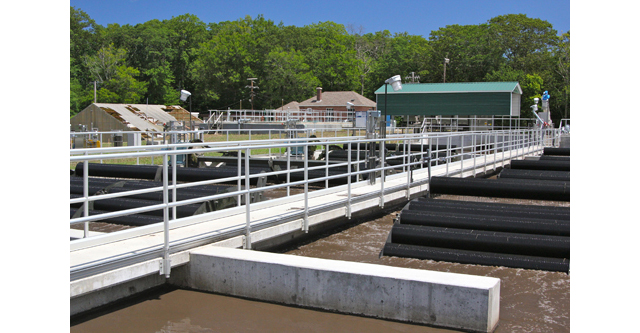Trustee makes case before Southold Dems to extend village sewers


Speaking before the Southold Town Democratic Committee Tuesday evening, Greenport Village Trustee Jack Martilotta gave a presentation on expanding the village’s sewer district into some unincorporated parts of Greenport.
Whether that will become a reality, however, remains to be seen.
Greenport Mayor George Hubbard Jr., who was not invited to Tuesday’s meeting, said in an interview Wednesday that the village has been investigating potential funding sources for the proposal in recent months. The previous village administration had commissioned a study by engineering firm Dvirka and Bartilucci on a possible expansion. That report was submitted in February 2015, according to the mayor.
Mr. Hubbard said the village has not formally voted to move forward with any expansion.
Nevertheless, Mr. Martilotta, a Greenport Middle School science teacher, explained to the town Democratic committee that the village sewage treatment plant is currently operating at about half its maximum capacity and could take on additional sewage flow.
Meanwhile, there are neighborhoods just outside village boundaries that are not hooked up to the sewer plant, and use traditional septic systems. Many of these properties, he said, are in areas within 10 feet of the water table and have medium to dense housing, which can threaten water quality.
The engineering study the village commissioned breaks the potential expansion down into three segments.
One is the area stretching from the western village boundary on Sixth Street to an area further west, at about 9th Street, Mr. Martilotta said.
This area includes about 60 homes, all of which use septic systems, he said.
Another target area is just north of the village boundary on Main Street, stretching toward Route 48, where about 75 existing homes are using septic systems.
The final piece — which includes a piece of the incorporated village that is not hooked up to the sewer system — is the area near Sterling Basin. This part of town has about 40 homes and about 150 boats in the summer, Mr. Martilotta said.
The cost of connecting all three areas to village sewers would be about $6 million, he said.
“But it would get rid of all those septic systems and it would eliminate all that stuff from going into the bay,” he added.
Sewer system extensions generally require affected property owners to pay for the hookup, as well as for daily sewer usage, Mr. Martilotta said.
He said he believes a number of funding sources are available, including a proposal on the November ballot to allow up to 20 percent of the existing Community Preservation Fund tax to be used for water quality projects, subject to voter approval in each of the five East End towns.
The CPF, which comes from a 2 percent land transfer tax, is used primarily for open space and farmland development rights purchases.
Greenport Village is the only area of Southold Town that has a sewage treatment plant.
It will be up to Southold Town to formally schedule the referendum on the CPF change, which was authorized by state law in December.
The town Democratic committee voted by way of a show of hands to invite Southold Supervisor Scott Russell, a Republican, to speak on the issue at a future meeting. Reached by email Wednesday, Mr. Russell said he’d be happy to do so.
“The idea of improving water quality is important,” he wrote. “I would welcome the opportunity to discuss it in any venue.”
Mr. Russell said he’s aware of the Greenport engineering study, which was sent to him by village officials.
“There are several impediments that I can see,” he said. “First, the CPF extension hasn’t even been voted on by the community yet and it’s probably bad public policy to try to spend money that doesn’t yet exist.”
He said the town and village would have to prioritize what projects to use the funding on, and would have to be shrewd in doing so, since there won’t be enough to accommodate all of the work that needs to be done.
The town and village will need to “establish criteria, identify priorities, identify priority areas and undertake a full environmental impact analysis to determine with projects give us the most bang for our buck,” Mr. Russell wrote. “The plan that they are discussing factors in none of that.”
The supervisor said the proposed vote in November would not create additional funding and that the town would have divert CPF revenue from existing preservation programs in order to use it for water quality improvement programs, such as the Greenport sewer extension.
Glynis Berry, executive director of Peconic Green Growth, a nonprofit that deals with sewage issues on the East End, also attended Tuesday’s meeting. She said concerns about the proposed sewer extension leading to increased development are mitigated by the fact that most of the areas proposed for the extension are already developed with homes that have existing septic systems, so there’s little room for new development.
Both Mr. Hubbard and Mr. Russell questioned why the presentation was given at a political committee meeting, which the supervisor called a “rather odd approach.”
Mr. Hubbard said Mr. Martilotta was speaking for himself Tuesday and not the Village Board.
“He didn’t ask the board for permission and the board didn’t sanction what he said,” Mr. Hubbard said Wednesday.
Southold Democratic chairman Art Tillman said he’d been speaking informally about this subject with Greenport Trustee Doug Roberts and asked Mr. Roberts if would speak to the club about it. Mr. Roberts was unable to make it Tuesday and sent Mr. Martilotta in his place.
Credit: The Greenport Village sewage treatment plant. (Credit: Jen Nuzzo, file)








